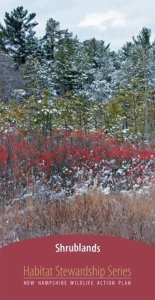National Wildlife Federation
UNH Cooperative Extension
UNH Cooperative Extension
UNH Cooperative Extension
UNH Cooperative Extension

UNH Cooperative Extension
UNH Cooperative Extension
NH Audubon
Grow Native Massachusetts
Homegrown National Park
Mass Audubon
UNH Cooperative Extension
NH Fish & Game
Photo caption: Eastern Bluebird on a nest box at the Massabesic Audubon Center, NH.
Photo caption: While Oriental Bittersweet can provide food and shelter for birds, the plant can quickly overwhelm native plants and is now banned from sale in New Hampshire. Photo credit: Pam Hunt
A nonprofit statewide membership organization, independent of National Audubon, dedicated to the conservation of wildlife and habitat throughout the state. Bird information is provided through the quarterly publication New Hampshire Bird Records
The Department is charged with conserving all the wildlife in the state, both game and nongame species. At the Department’s web site you can find wildlife information and links to the New Hampshire Wildlife Action Plan.
Extension serves a valuable role in providing outreach and technical assistance to landowners across the state. At their web site you can find links to habitat management recommendations and information on programs offered by Extension.
This non-profit organization is among the leading advocates for bird conservation in the United States and elsewhere in the Western Hemisphere. It is active in many of the issues identified in this publication.
Includes links to the 2019 Science paper mentioned in the introduction.
The oldest of the bird initiatives, formed in 1986, primarily concerned with the conservation of ducks, geese, and swans.
Assumes responsibility for conservation planning for landbirds, a broadly defined group that includes all species other than shorebirds, waterfowl, waterbirds, and resident game birds.
Here you can find copies of the national State of the Birds documents.
Works to conserve North American shorebird populations through a combination of research, monitoring, and conservation planning.
Focused on a broad selection of wetland and marine birds that includes colonial waterbirds (e.g., herons and terns), marshbirds (e.g., rails and bitterns), and other solitary species such as loons.
This worldwide database of bird sightings includes the New Hampshire data that was formerly collected by NH Audubon.
The BBS is a nationwide bird monitoring system established in 1966. It includes thousands of 25-mile roadside routes that are surveyed annually during the breeding season. The BBS website allows users to look up trends for any species or region, as well as providing a wealth of other information relevant to bird conservation.
This annual winter bird count began in 1900 and is the oldest survey of its kind. It is conducted by volunteers and coordinated by the National Audubon Society.
The Breeding Species table includes all species that have bred in New Hampshire over approximately the last two decades.
Italics = Rare or irregular breeders
B = Habitats in which a species breeds
N = Additional habitat where the species occurs during migration or winter
If a species in either table is considered a Species of Greatest Conservation Need (SGCN), it is assigned one of the following categories:
X = Species listed as an SGCN in the 2015 New Hampshire Wildlife Action Plan
SC = Special Concern in NH
T = Threatened in NH
E = Endangered in NH
R = Considered a Regional SGCN in the northeastern United States (only shown if a species is not in any of the previous categories)
General Trend:
II = Strong increase
I = Moderate increase
S = Stable
D = Moderate decrease
DD = Strong decrease
U = Unknown
Contact Headquarters

National Wildlife Federation Affiliate
Website By CleverLight
Information for the species profiles on this website was compiled from a combination of the sources listed below.
The Birds of New Hampshire. By Allan R. Keith and Robert B. Fox. 2013. Memoirs of the Nuttall Ornithological club No. 19.
Atlas of the Breeding Birds of New Hampshire. Carol R. Foss, ed. 1994. Arcadia Publishing Company and Audubon Society of New Hampshire
Birds of the World. Various authors and dates. Cornell Laboratory of Ornithology.
Data from the Breeding Bird Survey
Data from the Christmas Bird Count